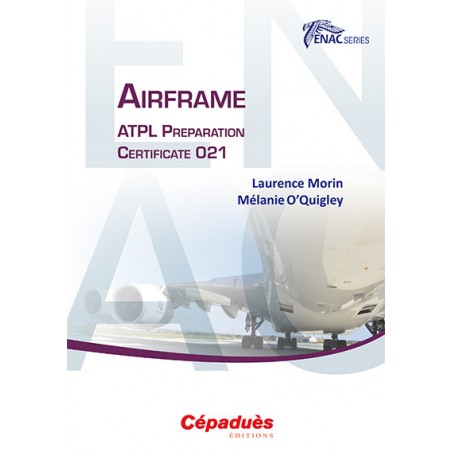






Commande avant 16h,
expédié le jour même (lu. - ve.)

Livraison express sous 48h.
SUMMARY
INTRODUCTION
1STPART:AIRFRAME STRENGTH
CHAPTER1:BASICPRINCIPLESOFMECHANICSOFMATERIALS
CHAPTER 2: DESIGN METHODS
CHAPTER 3: STRUCTURAL MAINTENANCE
CHAPTER 4: AERONAUTICAL MATERIALS
CHAPTER 5: BASIC NOTIONS OF AEROELASTICITY
2ND PART: AIRFRAME
CHAPTER 1: WINGS (ATA 57)
CHAPTER 2: FUSELAGE (ATA 53)
CHAPTER 3: STABILIZERS (ATA 55) AND CONTROL SURFACES
CHAPTER 4: PRIMARY FLIGHT CONTROL SYSTEM (ATA 27)
CHAPTER 5: SECONDARY FLIGHT CONTROL SYSTEM (ATA 27)
CHAPTER 6: LANDING GEAR (ATA 32)
CHAPTER 7: TIRES WHEELS - BRAKES (ATA 32)
AIRCRAFT TIRES
APPENDIX 1: Methods of inspection for structural parts
APPENDIX 2 : Standardized designation of light alloys
APPENDIX 3: ATA 100 STANDARD (NON-EXHAUSTIVE)
SUMMARY
INTRODUCTION
1STPART:AIRFRAME STRENGTH
CHAPTER1:BASICPRINCIPLESOFMECHANICSOFMATERIALS
CHAPTER 2: DESIGN METHODS
CHAPTER 3: STRUCTURAL MAINTENANCE
CHAPTER 4: AERONAUTICAL MATERIALS
CHAPTER 5: BASIC NOTIONS OF AEROELASTICITY
2ND PART: AIRFRAME
CHAPTER 1: WINGS (ATA 57)
CHAPTER 2: FUSELAGE (ATA 53)
CHAPTER 3: STABILIZERS (ATA 55) AND CONTROL SURFACES
CHAPTER 4: PRIMARY FLIGHT CONTROL SYSTEM (ATA 27)
CHAPTER 5: SECONDARY FLIGHT CONTROL SYSTEM (ATA 27)
CHAPTER 6: LANDING GEAR (ATA 32)
CHAPTER 7: TIRES WHEELS - BRAKES (ATA 32)
AIRCRAFT TIRES
APPENDIX 1: Methods of inspection for structural parts
APPENDIX 2 : Standardized designation of light alloys
APPENDIX 3: ATA 100 STANDARD (NON-EXHAUSTIVE)
| Référence : | 1115 |
| Nombre de pages : | 180 |
| Format : | 17x24 |
| Reliure : | Broché |
| Rôle | |
|---|---|
| Morin Laurence | Auteur |
| O'Quigley Mélanie | Auteur |
Table of CONTENTS
INTRODUCTION
1ST PART:AIRFRAME STRENGTH
CHAPTER1:BASICPRINCIPLESOFMECHANICSOFMATERIALS
1 Introduction–Mechanicsofmaterials
2 Forcesinvolved
2.1 Deformationofasolidduetotheappliedforces
3 Stressesinsolids
3.1 Highlightingthestresses
3.2.Normalstressandshearstress
3.3.Sizing–General
4 Stress-strainrelationshipexample:tension
4.1 Fundamentalexperiment
5 Compressionandbuckling
5.1 Platebuckling
6 Simpleshear
7 Bending
8 Torsion
9 Stressdistributioninthevariouselementsofasimplestructure
9.1 Normalload
9.2 Shearingload
9.3 Bendingmoment
9.4 Torsionalmoment
9.5 Distributionofstressonstructuralelements
CHAPTER 2: DESIGN METHODS
1 Introduction
2 Rupture modes
2.1 Static rupture
2.2 Fatigue rupture
2.3 Dynamic instability
2.4 Rupture by cracking
2.5 Parts exposed to high temperatures
3 Certification levels (Paragraph 1309)
3.1 Failure types
3.2 Probability of occurrence
3.3 Conclusion
4 Load calculation – General
4.1 Loads supported by the aircraft
4.2 Load types (limit load, ultimate load, in-service load)
5 Static proof
6 Proof of fatigue strength and damage-tolerance
6.1 1st step: Definition of fatigue loads
6.2 2nd step: Proof3
7 Design types
7.1 History
7.2 Definition of concepts
CHAPTER 3: STRUCTURAL MAINTENANCE
1 Introduction
2 The ATA 100 Standard
3 Maintenance modes
3.1 Introduction
3.2 Preventive maintenance
4 Issuing the maintenance program for a new aircraft
4.1 Purpose and actors
4.2 At the operator’s premises: scheduled maintenance
CHAPTER 4: AERONAUTICAL MATERIALS
1 Introduction
2 Main properties
2.1 Chemical properties
2.2 Physical properties
2.3 Mechanical properties
2.4 Environmental properties
2.5 Implementation
2.6 Economical properties
3 Material selection
1ST CATEGORY: METALLIC MATERIALS
4 Steel.
4.1 Chemicals properties
4.2 Physical properties
4.3 Mechanical properties
4.4 Environmental properties
4.5 Implementation
4.6 Economy
4.7 Conclusion-use
5 Light alloys
5.1 Chemicals properties
5.2 Physical properties
5.3 General properties
5.4 Main light alloys used in airframes
6 Ultra-light alloys
6.1 Chemicals properties
6.2 Physical properties
6.3 Mechanical properties
7 Titanium and titanium alloys
7.1 Chemicals properties
7.2 Physical properties
7.3 Mechanical properties
2ND CATEGORY: COMPOSITE MATERIALS
8 General
8.1 Definition
8.2 Anisotropy and lay-up53
9 Constituents
9.1 Fibers
9.2 Matrixes.
10 Advantages and disadvantages of using composite materials
10.1 Advantages
10.2 Disadvantages
11 Sandwich materials
11.1 Definition
11.2 Properties
CHAPTER 5: BASIC NOTIONS OF AEROELASTICITY
1 Static aeroelasticity : aileron reversal
1.1 What is it?
1.2 What happened?
1.3 Remedies
2 Dynamic aeroelasticity
2.1 Calculation of dynamic loads
2.2 Vibrations
2.3 Example of instability: flutter
2ND PART: AIRFRAME
CHAPTER 1: WINGS (ATA 57)
1 General
1.1 Wing position
1.2 Wing types
2 Applied loads
2.1 Nature
2.2 General stresses
3 Construction modes
3.1 Spars
3.2 Ribs
3.3 Skin and stringers
4 Stress PICK-UP in the box constituents
4.1 Reminder: Distribution of stresses in a simple structure
4.2 Application to the wing box
5 Special points
5.1 MZFW limitation
5.2 Tanks
CHAPTER 2: FUSELAGE (ATA 53)
1 The various types of fuselage
1.1 Introduction
1.2 The various types of fuselage
1.3 Pressurized areas
1.4 Different fuselage cross-sections
2 Applied loads
2.1 Nature
2.2 General loads
2.3 Abnormal operation fuselage loads
3 Construction modes
3.1 Frames
3.2 Skin and stringers
3.3 Assemblies
4 Load pick-up in fuselage cross-sections
5 Fuselage openings
5.1 Windshields
5.2 Passenger doors
5.3 Cargo compartment doors
6 Floor
7 Fire Protection
CHAPTER 3: STABILIZERS (ATA 55) AND CONTROL SURFACES
1 General
1.1 Tail units
1.2 Vertical section
1.3 Horizontal section
1.4 Arrangement of stabilizers
2 Applied loads
3 Control surfaces: General
3.1 Definition
3.2 Ground locking of control surfaces
4 Control surface defects
4.1 Adverse yaw
4.2 Aeroelasticity-related problems
5 Aerodynamic balance
5.1 Inset hinge
5.2 Internal balance
5.3 Tabs
6 Trimming of control surfaces
<p class="MsoNormal" style="margin-top: 0cm; margin-right: 3.35pt; margin-bottom: .0001pt; margin-left: 29.3pt;
Livres de l'auteur Laurence Morin
Livres de l'auteur Mélanie O'Quigley